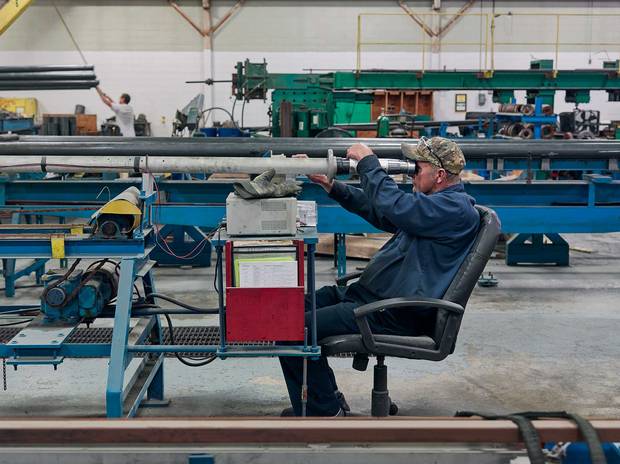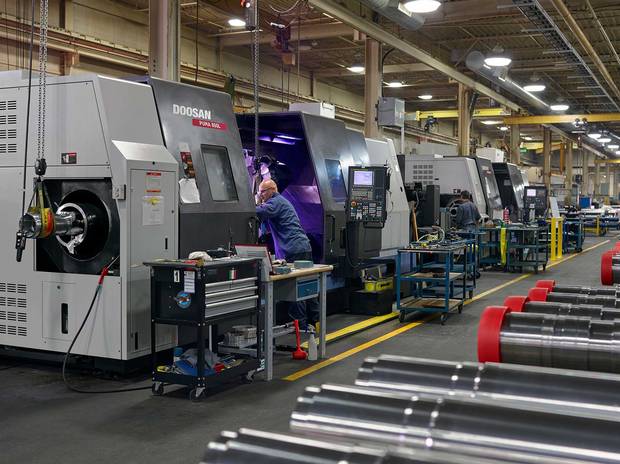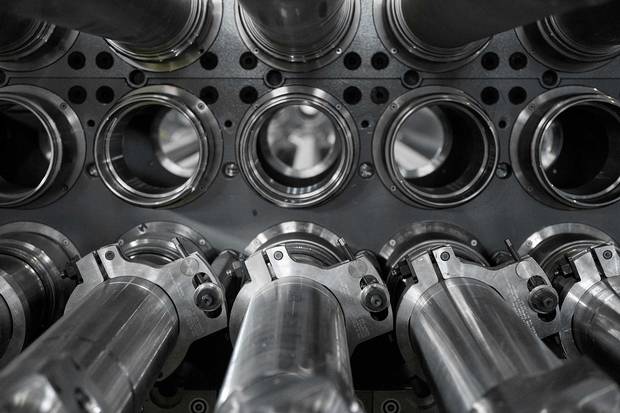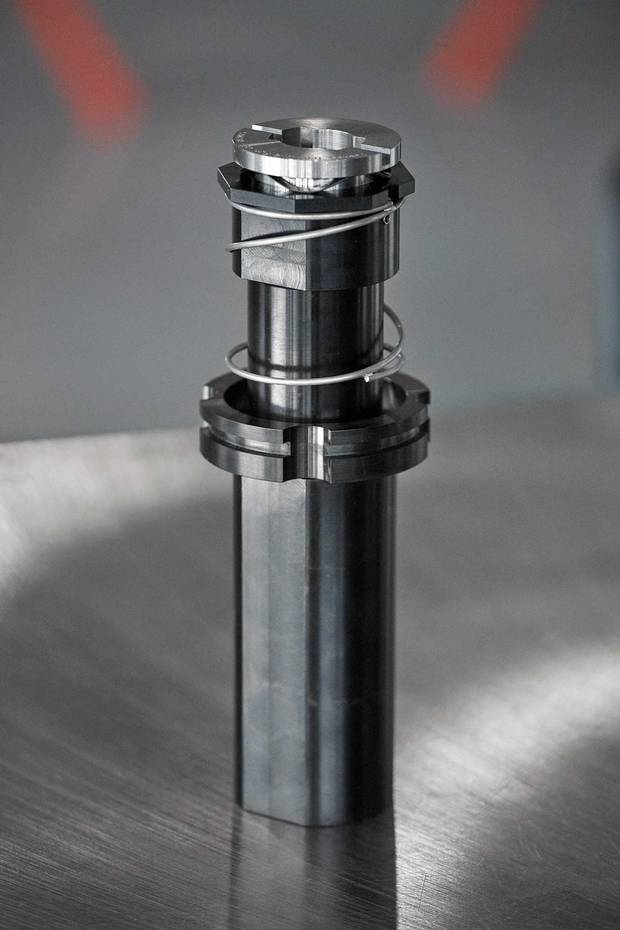
At the 65,000-square-foot training facility in Bowmanville, Ontario, workers in radiation suits do drills in a mock-up of a Candu reactor to get ready for the actual overhaul. It can also serve as a simulator where workers can hash out problems if things go wrong during the refurbishment. “It’s like in Apollo 13, when the astronaut in the simulator was able to help those on the spacecraft,” says OPG’s Scott Berry.
Ontario's 18 nuclear reactors provide 60% of the province's electricity. The two most prolific power plants (whose Candu reactors run on natural uranium, which can't be used in bombs) are getting up there in age. The Bruce Nuclear Generating Station's first reactor came online in 1977, Darlington's in 1990.
Last year, Ontario Power Generation embarked on a 10-year, $12.8-billion refurbishment of Darlington's four reactors—which provide enough juice for two million people. It's the largest clean-energy project ever undertaken in Canada (at least until the Bruce's 15-year upgrade begins in 2020) and should ensure the reactors in Bowmanville, Ontario, run for the next 30 years.
Some 96% of the work will be done by local companies, six of which are profiled here. Many of these suppliers helped build Darlington and then switched focus to what was at that time a booming automotive sector. The tide has turned again, and many companies are shifting back to nuclear, hiring skilled tradespeople who've been thrown out of work in the oil patch.
For the past year, those workers have been honing their skills in a $38-million full-scale mock-up of the Candu reactor. "It's the first of its kind in the world, and we can do numerous tests on what could go wrong and see what works and what doesn't," says OPG's Scott Berry. "It also gives employees who've never worked in a radioactive environment confidence before they go into a real reactor."

Inside the reactor core, natural uranium atoms are split into neutrons (helped and moderated by heavy water), a process that generates heat. That heat produces steam, driving a turbine and creating electricity
Nu-Tech Precision Metals
Arnprior, Ontario
Employees: 50

Rick Kwiatkowski, who has worked at Nu-Tech for 42 years, uses a borescope—a sort of periscope with slight magnification—to visually inspect each tube for microscopic scratches in the special oxide coating. The company uses ultrasonic and eddy-current testing, as well, but nothing beats the human eye for peering inside the tubes.
A reactor's 480 zirconium pressure tubes hold the uranium fuel that splits into neutrons during fission. The tubes run horizontally through the core of the reactor (a.k.a. the calandria) and move the neutrons through hot, pressurized heavy water to a steam generator. George Legate, president of Nu-Tech Precision Metals, likens all that pressure to "the weight of a Jeep Grand Cherokee carrying two tons of cargo rolling over your foot." And the water is hot—about 300 C.
Over the decades, all that heat, pressure and radiation have caused the tubes to sag and stretch, and they need to be replaced. Nu-Tech has built every eight-metre-long tube for every Candu reactor since 1954. Some of Legate's employees built the original tubes for Darlington three decades ago, and he credits them for helping Nu-Tech stay competitive. "These tubes are expensive—the raw material is 100 times the price of stainless steel—so we need to minimize the number of tubes that have to be scrapped," says Legate. "We rely on a high degree of tribal training." That means employee retention and painstaking documentation of each process is key. The tubes are melted in a vacuum four times (compared to once for aircraft parts) to ensure they're uniform and to eliminate impurities. Any flaw larger than a human hair renders the tube useless.
BWXT Canada Ltd.
Cambridge, Ontario
Employees: 850

These two shutdown coolers are waiting in BWXT’s clean room, ready to be shipped to Darlington. Each of the plant’s four reactors requires two coolers.
Roughly every 36 months, a reactor has to be shut down for maintenance. That's where BWXT's shutdown cooler comes in. It pumps water from Lake Ontario through its tubes to cool the so-called decay heat while the reactor is offline. That warm water is then returned to the lake. The cooler, which looks like an eight-metre-long horizontal cylinder filled with hundreds of high-nickel-alloy tubes and support components, is built at BWXT's 275,000-square-foot Cambridge facilty. Final assembly of the 39-tonne cylinders is done in BWXT's "clean room"—the largest one in North America for the assembly of nuclear components. It takes roughly two years to get from design to delivery, and BWXT has been modernizing its manufacturing facilities to deal with increased demand created by the Darlington and Bruce refurbishments.
In late 2016, BWXT acquired GE Hitachi Nuclear Energy Canada, which supplies fuel for Candu reactors. BWXT is also making 7,680 new feeder pipes that will bring coolant into the four reactors, ensuring they don't overheat. The pipes vary in length between 10 and 38 feet, and each must be bent at precise angles to ensure it fits exactly into its corresponding fuel channel.

Some of the 7,600-odd feeder pipes BWXT is manufacturing to bring coolant into the reactors.
Triumph Gear Systems
Toronto
Employees: 200

Pasquale Abbruzzese, who has worked for Triumph for 35 years, is setting an end fitting so the computer-run machine knows exactly where to cut. Triumph still employs 23 people who worked on earlier nuclear projects, and they’re training 30 new hires to help with the refurbishment.
End fittings might not sound like the sexiest product, but inside a nuclear reactor, they play a crucial role. Triumph Gear Systems' end fittings are found at the end of each fuel channel, and allow for the transfer of new fuel into the reactor and removal of the used stuff. The end fittings—Triumph is making almost 3,500 for the Darlington overhaul—also connect to the coolant-filled angled feeder pipes.

A worker at Toronto’s Triumph Gear Systems crafts shield plugs for end fittings.
The high-quality American stainless steel is forged at Patriot Forge in Brantford, Ontario. The process takes 12 weeks, during which time the metal is continuously checked to ensure its chemistry and grain structure remain consistent and there are no bubbles or cracks. After the ingots arrive at Triumph, it takes 20 more weeks to make one end fitting. The company (which was known as Donlee Nuclear Inc. back when it built 3,840 end fittings for the original project) also makes the shield plugs that go into the end fittings and prevent radiation from escaping the reactor core.
ATS Automation Tooling Systems Inc.
Cambridge, Ontario
Employees: 600

ATS Automation helped develop the bellows cut tool, which will help remove the reactor’s fuel channels.
Since it was founded in 1978, ATS Automation has worked on more than 100 nuclear projects. At its Cambridge headquarters (it has 23 manufacturing facilities in North America, Europe and Asia, with a total of 3,500 employees), ATS helped design and build more than 150 automated tools and systems for the Darlington project. The bellows cut tool, developed in partnership with SNC-Lavalin and Aecon, has a very specific job: to precisely cut off the irradiated chunks of metal (called bellows) that attach the reactor's end fittings to the fuel channels, which are the key component in the core that's being replaced. The cut tool finds the right place on the joint to cut, and then pulls and rotates the end fitting into the correct position for the next step in the removal process.
Promation
Oakville, Ontario
Employees: 110

At the mock-up facility, workers put Promation’s loading table through its paces. Its job is to shove 13 fuel bundles into each fuel channel, which is then loaded into the core.
Darryl Spector likens loading uranium-pellet-packed fuel bundles into the reactor's fuel channels to loading bullets into a rifle. Workers hoist each 50-pound bundle onto a trough on the aptly named fuel-loading table, where it slides into the fuel channel. The 500-pound adjustable table was designed by engineers at SNC-Lavalin and built by Promation. The first one took 14 weeks to make, with the remaining three (one is required for each reactor) taking just 10. "This isn't like an instruction model kit from Ikea," says Spector, Promation's general manager of operations. "We had challenges with the first design, but then you figure it out and the next one is easier."
Promation started out in 1995, making auto components. But when that sector crashed, it refocused on nuclear, which now accounts for about 60% of its revenue. "Nuclear has a lot more quality assurance and safety tests—we have to audit our suppliers every one to three months to ensure they're meeting standards," says Spector. "A lot of the new guys who come into this business find that the biggest barrier is procedural compliance and quality assurance."
Promation is also building other tools and components for the Darlington refurbishment, and it anticipates getting further work on the Bruce overhaul. Its tables are also being used by SNC-Lavalin on a Candu reactor in Argentina.
BC Instruments
Schomberg, Ontario
Employees: 145

The material for the yoke, stud and nut in each positioning assembly (which clamps onto the end fittings) comes from North American steel mills, though some of it is custom-made in Germany. BC Instruments sent its quality-assurance manager to the German mill to oversee the process.
Pressure tubes are constantly bombarded by neutrons, and as the years go by, all that radiation adds atomic particles to the tubes that cause them to grow. The yoke, stud and nut in each positioning assembly act as a "glorified clamp and clothespin, and support the growth of the pressure tube," says BC Instruments president Roger Conzellman. The stud is even threaded so it can be adjusted as the entire tube shifts. Conzellman's father, Bruno, started the company in his one-car garage in 1971, producing parts for the aerospace industry and, eventually, working with Atomic Energy of Canada Ltd. Today, BC Instruments has six Ontario plants—four in Schomberg and two in Orillia—and makes parts for the aerospace, medical, plastic-injection moulding and electronics industries. Nuclear accounts for roughly one-fifth of its business. "While the machining for nuclear is not more difficult than aerospace or injection-mould components, the administration, traceability, testing and certifying is what needs to be overseen meticulously," says Conzellman. "We still have our files from the late 1970s."

One of BC Instruments’ positioning assembly yokes—which company president Roger Conzellman calls “a glorified clamp and clothes pin.”